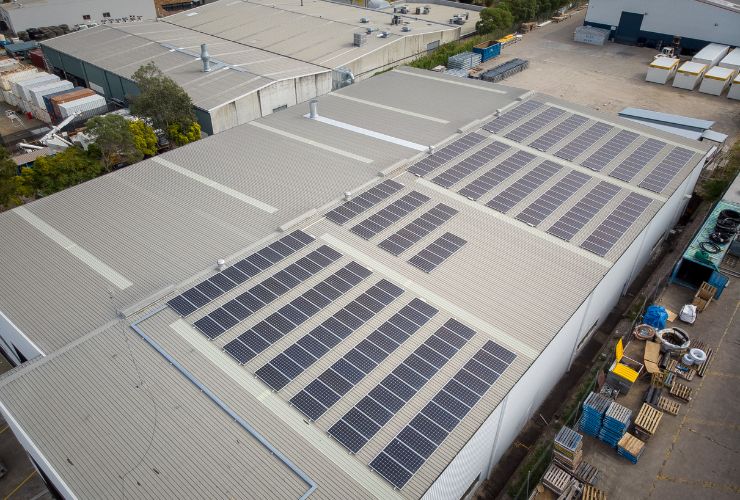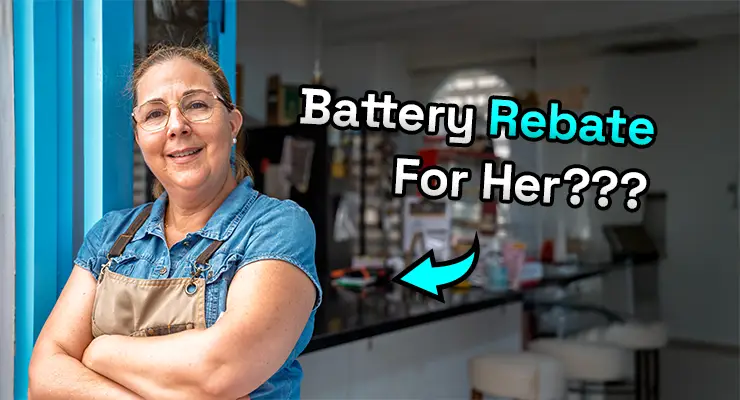Fast read
Commercial properties can greatly benefit from battery storage, with significant new government support available from 1 July 2025 through the federal Cheaper Home Batteries Program. This program offers an upfront discount for small businesses on new battery systems, which can often be combined with incentives for joining a Virtual Power Plant. Key benefits for businesses include managing high peak demand charges, providing backup power for critical operations, and maximizing the use of onsite solar energy.
Beyond Solar: Why Batteries Are Now a Strategic Business Decision
It’s a common question we hear from business owners: Solar panels make sense, but does adding a battery? For many Australian businesses, the answer is increasingly yes. Installing a battery energy storage system (BESS) is no longer just about being green—it’s a strategic financial decision that provides energy security and control over one of the most volatile costs a business faces.
This article will walk you through how batteries can work for your commercial property, the significant government rebates available to reduce the upfront cost, and the key steps to consider before you make a decision.
How can a battery system benefit my business?
For a commercial property, a battery system offers several powerful advantages that go beyond simply storing solar power. These benefits directly target the unique way businesses are billed for electricity.
- Slash peak demand charges: Many businesses pay not only for the amount of electricity they use but also a separate “demand charge.” This charge is based on the highest point of electricity usage during a billing period. A battery can be programmed to discharge during these peak times, drastically lowering your demand from the grid and cutting a major component of your power bill. This strategy is often called ‘peak shaving’.
- Maximise your solar investment: If you already have solar panels, a battery allows you to store the excess clean energy generated during the day and use it during the evening or overnight. This means you avoid exporting it for a low feed-in tariff and then buying expensive grid power after the sun goes down, significantly increasing your energy self-sufficiency.
- Ensure business continuity with backup power: What would a power outage cost your business in lost productivity, data, or sales? For many, the cost is significant. A commercial battery can provide near-instant backup power to keep critical systems—like servers, lights, payment systems, and security—running smoothly during a grid failure.
- Unlock new revenue streams: By joining a Virtual Power Plant (VPP), your battery can be used to help stabilise the wider electricity grid. In return for allowing a VPP operator to draw small amounts of power from your battery during times of extreme grid demand, you can earn credits or payments, creating an additional source of revenue.
The new federal rebate: The Cheaper Home Batteries Program
This is a game-changer for businesses considering energy storage. Starting from 1 July 2025, the Australian Government’s Cheaper Home Batteries Program will provide significant financial support for battery installations by extending the existing Small-scale Renewable Energy Scheme (SRES).
This program will provide an upfront discount on the cost of an eligible battery system via the creation of Small-scale Technology Certificates (STCs). The key details for businesses are:
- Eligibility: The program is open to small businesses installing a new battery system connected to a new or existing solar PV system.
- System size: Systems with a total nominal capacity between 5 kWh and 100 kWh are eligible to create STCs. However, the value of the discount is calculated based only on the first 50 kWh of the battery’s new or added usable capacity, which is an important distinction.
- Timing is crucial: To be eligible, the battery system must be fully installed and certified (as per the state/territory certificate of electrical compliance) on or after 1 July 2025.

Can I combine the federal rebate with other incentives?
This is a key consideration for maximising your return on investment. The rules can be complex, but here is a general guide:
Generally, you cannot “stack” the federal Cheaper Home Batteries Program discount with a state-based discount for the same piece of hardware. Many state governments have adjusted their schemes in light of the new federal program. For example, some state battery hardware rebates are scheduled to end as the federal scheme begins.
However, the federal discount can often be combined with incentives for participating in a program, like a VPP. In some states, for instance, from 1 July 2025, businesses may be able to access the federal discount and also receive an incentive for connecting their new battery to a VPP.
In Western Australia, the state and federal governments are delivering a combined program to provide a larger total rebate. Through a seamless application process, the state and federal rebates are “stacked” to increase the total financial support available to eligible households and businesses.
Because these schemes are dynamic, it’s essential to verify the specific rules for your state and situation at the time of purchase.
What makes a commercial battery installation different?
While the principles are the same, a commercial installation is more complex than a residential one. It’s crucial to work with an installer who has specific experience in the commercial sector.
Sizing the system correctly is the most critical step. A commercial installer won’t just look at your electricity bill; they will perform a detailed load analysis. This involves studying your energy consumption patterns throughout the day and year to determine not just the right storage capacity (kWh) but also the required power output (kW) to meet your peak demand.
Commercial properties also typically use three-phase power, requiring compatible, robust inverters and batteries. Scalability is another key factor. A modular system can be a smart choice for a growing business, allowing you to expand your storage capacity as your energy needs increase. The inverter is the brain of the operation, and proven commercial-grade hybrid inverters are designed to efficiently manage the complex power flows between your solar panels, battery, the grid, and your business operations.
What are the first steps to take?
Feeling informed is the first step, and taking action is the next.
- Analyse your energy usage: Gather your electricity bills for the last 12 months. This will give a professional installer the initial data they need to understand your usage patterns and the potential impact of demand charges.
- Define your goals: Are you primarily looking for backup power, bill reduction, or both? Your primary motivation will influence the ideal system design.
- Consult an accredited professional: To qualify for government rebates like the Cheaper Home Batteries Program, key conditions must be met. First, your installer must be accredited by Solar Accreditation Australia (SAA) for battery installations. Second, the hardware you install—both the battery system and the inverter—must be on the Clean Energy Council’s (CEC) respective lists of approved products. An accredited professional can provide a detailed site assessment, load analysis, and a clear proposal outlining costs, savings, and payback periods.
Making the move to battery storage is a significant investment, but with the right advice and the available government incentives, it can deliver substantial returns for your business. It provides a powerful way to reduce overheads, improve resilience, and demonstrate a commitment to sustainability.



